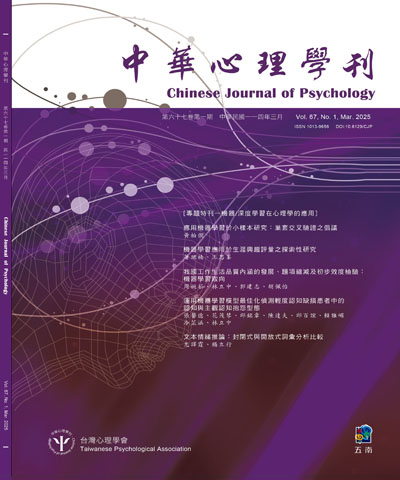
選擇卷期
- 期刊
強暴迷思的概念與測量具有在地性、變遷性,並與社會文化特色密切相關,因此不能僅移植西方的概念或使用西方的量表。本研究從傳統華人社會文化角度出發,提出華人的強暴迷思概念,並據以建立測量工具。華人重視家庭、關係、修身、德性、他人評價,故作者從這些面向思考並整合過去的研究經驗,提出華人家庭取向、貞潔取向、他人取向、與自省取向的強暴迷思特徵。本研究以無記名自陳式問卷調查法蒐集資料,研究對象包括5所公立、7所私立大學的學生,經剔除廢卷後得有效問卷969份。結果發現,上述華人強暴迷思的特徵中,家庭取向迷思可分為被害延伸與加害延伸兩項迷思,貞潔與他人取向迷思可合併為一個構念,而得到四項構念或分量表:被害延伸迷思、加害延伸迷思、貞潔與他人迷思、自省迷思。整體量表具備良好的內部一致性信度與組合信度,並具備構念效度、複合效度、與效標關聯效度。文末討論研究結果的理論意涵、實務應用、研究限制、與未來研究方向。
- 期刊
The Internet can stimulate social relationships, but it can also reduce the quality of real-world social relationships if over-used. There has been insufficient evidence about the relationship between Internet use and social stress. The aim of this study was to investigate whether social stressors are associated with social Internet use in terms of the reduction and stimulation hypotheses. Using longitudinal data from 430 students over three years, we first conducted a latent class analysis (LCA) to determine students' latent classifications based on three self-reported social stressors at each time point. These three stressors related to intimate relationships, peer relationships, and parent-adolescent relationships. Latent transition analysis (LTA) was then conducted to examine how the latent classifications changed over time, and transition patterns were identified. In the next stage, the relationship between stress transition patterns and social Internet use was assessed. The findings indicated that students could be classified as having "high social stress" or "low social stress" at each time point. The transition patterns included "all high," "all low," and "improving." The results showed that students who frequently used the Internet to make new friends experienced high social stress both initially and over time. Increasing Internet use to find boyfriends/girlfriends may have reduced later social stress. However, frequently using the Internet to maintain existing relationships did not affect social stress transitions. In sum, using the Internet for social purposes does not necessarily reduce social stress. Students should employ effective and direct stress coping methods instead of the Internet to release their social stress.
- 期刊
Face processing and recognition has been one of the most productive research areas in cognitive science over the past four decades, and in most studies images of real faces are the focus of inquiry. Owing to the proliferation of technology in social media in recent years, we have witnessed a significant surge of using line-drawn faces and expressions along with their real-face counterparts for purpose of communication. Here in two experiments we examined how line-drawn faces may differ from real faces in terms of identity and emotional expression processing. In Experiment 1, we used the part-whole task and showed that, compared to real faces, line-drawn faces were processed in a more part-based manner similar to non-face objects (i.e., houses). In Experiment 2, we tracked participants' eye movements while they performed a delayed matching-to-sample task, in terms of expressed emotion, where images of either real or line-drawn faces were used as the sample. In addition, we also examined the role a verbal label may play in identifying the facial expression that matched the description. We did this to test the idea whether facial expressions of line-drawn face were in general more symbolically coded than real faces such that a verbal label would be more effective in retrieving those expressed by line-drawn faces. The results indicated that while line-drawn faces differed from real faces in terms of identity processing, they may be quite similar in terms of expression processing. Furthermore, compared to real faces, providing a verbal label failed to offer any additional help locating the matched expression from line-drawn faces, after controlling for the potential speed-accuracy tradeoff with inverse efficiency scores. This might explain why it has become a common practice to exaggerate portrayed expression in line-drawn faces: To overcome the inherently vague signals of emotional expression.

